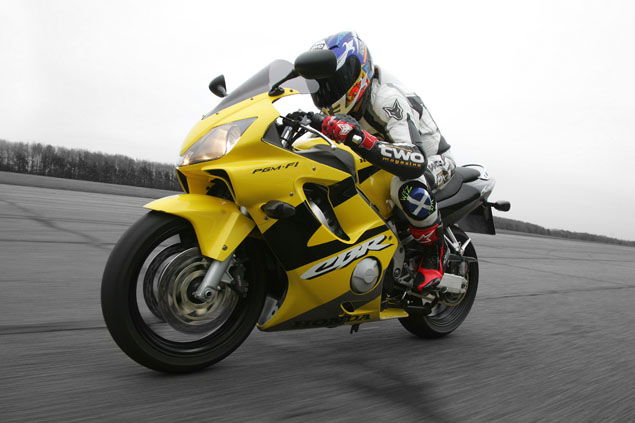Summer Fun - Suzuki GSX-R1000K2, KTM 690SM, Yamaha XJR1300 and Triumph Thruxton
Right now is the time for enjoying the sun on two wheels. Whether it’s maximum speed or maximum cool you’re after, we rounded up the four best second-hand bikes we could find for £4,000 that provide the biggest bang for your summer buck

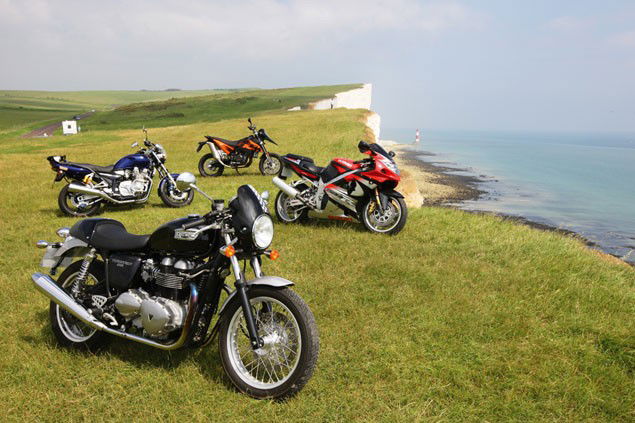
�
Summer and bikes is when it all makes sense. It’s what motorcycles were invented for. The nights are long, anything above 15 degrees is considered acceptable and suddenly you can’t wait to get out there. You’ve waited six long, dark months for this and now it’s time for your two-wheeled payback. The ride to work is something to be enjoyed, the tyres are warm, the roads grippy. Ride to the pub in jeans and a jacket and love every minute of it.
If you’re looking for a decently-priced bike to ride this summer, we’ve picked four of the best. The second-hand market is a glut of top quality, just-used bikes at the moment perfect for riding hard after a tough day in the office or cruising round to see your mates for a barbeque on a weekend. For the sportsbike nut, we’ve picked the original 2001 GSX-R1000. Light, basic and thrilling to ride, this 180mph lunatic was the King of Wheelies when it was released in 2000 and instantly disposed of the Yamaha R1. In the same vein is KTM’s 690SM, only a year old and perhaps the ultimate city and backroad blaster. And for those who prefer their summer’s riding without having to look behind them all the time for pursuing police officers, Yamaha’s timeless XJR1300 and Triumph’s brilliant Thruxton offer warm-weather thrills of a totally different nature.
Click next for the perfect bikes to kick back and enjoy the ride.
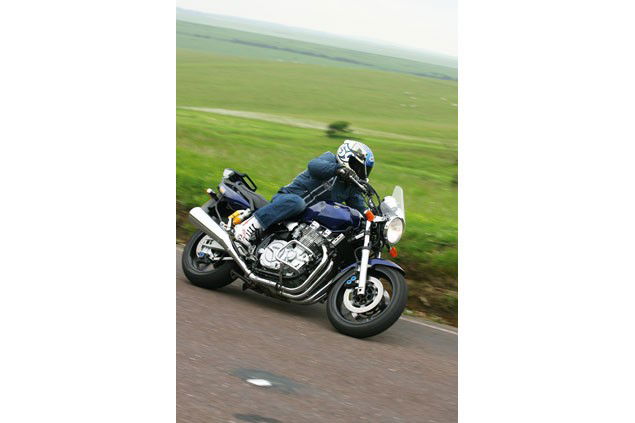
�
Yamaha XJR1300
Click to read: Yamaha XJR1300 owners reviews
Almost entirely unchanged for over 10 years, the XJR1300 has been tweaked into the best retro streetbike on the market. Great looks allied to an easy, grunty motor and mile-crunching ability make this a bike to smile on
When it comes to big-bore retro cruising Yamaha has cornered the market with its XJR1300. Over the last 10 years the XJR has successfully outlived pretenders such as Kawasaki’s ZRX1200 and Suzuki’s GSX1400 and proved a far greater success than Honda’s CB1300 thanks to its simple twin-shock, air-cooled retro look. It’s a popular second hand bike and a great summer machine. So what makes it special?
The great thing about the XJR is that it’s a lovable and practical bike. It’s not just designed for riders, pillions love the Yamaha thanks to its enormous seat and smooth motor. Which is a big part of its popularity. Try persuading the wife that your new £4,000 purchase isn’t just a selfish toy when she looks at a pillion seat the size of a fag packet stuck about 10 feet above the rider. You’re on a losing battle. Now get her to look at the XJR’s seat, let her feel its comfort, then mention summer runs to a country pub. She’s sold, you’re happy.
And the truth of the matter is that this is exactly what you’ll be doing on the XJR, because it’s fantastic at exactly that. Warm nights or sunny weekends, it doesn’t matter, the XJR’s huge engine will happily transport the pair of you to whichever location you choose with minimal fuss.
Click next to continue
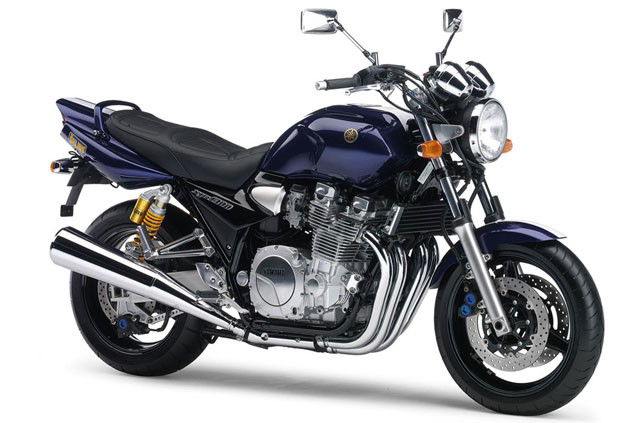
�
An air-cooled engine sounds old hat, but in the XJR’s case it ain’t. Instead it signifies a thoroughly developed engine that suits the bike’s character perfectly. The 1,251cc motor produces huge amounts of torque right through the rev range, which means that even two-up gear changes are a rare occurrence. It’s a smooth, almost turbine like, motor that wouldn’t even consider doing anything as uncivilised as vibrate or stutter at low revs. You’ll love the ride so long as you’re not in a mad rush, and the chassis only emphasises this pleasure.
The XJR is built to cruise, not hustle around corners so if you try and push it the chassis and suspension protests with a bouncy, wobbly ride. The shocks may come with Öhlins stickers but these aren’t GP units, the XJR is an image bike and those yellow springs are all part of this façade. But back the throttle off, settle down and the XJR delivers a comfortable, well damped ride, which is perfect for enjoying the scenery in an unhurried way.
The XJR is a classic case of a bike that has matured with time and is now a superb buy. In summer this bike shines and it’s almost impossible not to fall for its subtle charms. If you don’t want to spend your whole time riding solo there is no better summer bike for a spot of relaxed riding this year.
Niall Says
The big Yamaha has to be the best no nonsense all rounder out of the four bikes we tested. There is no getting yourself into a special riding position. You just climb on board, push the button and go. The smooth, bullet proof motor launches you effortlessly to 40mph or 140mph, and as the seat position is quite low there isn’t as much buffeting as you’d expect from a bike with very little protection. There are lots of shiny bits to polish and the Ohlins rear shocks (and stickers) add credibility although, unfortunately you won’t get R1 handling. If it is muscle you need this summer then I’d choose the Yamaha.
Click next to continue
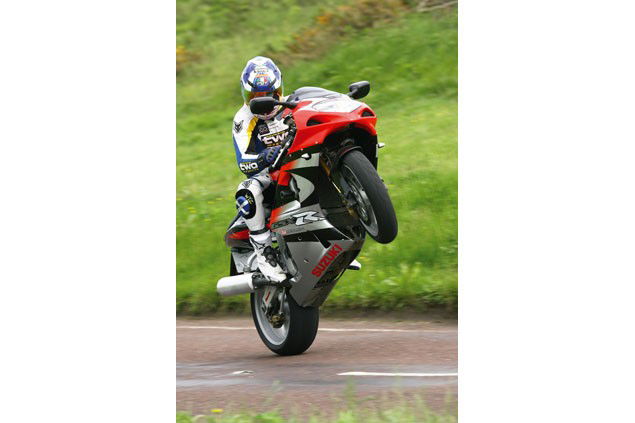
�
Suzuki GSX-R1000K2
Click to read: Suzuki GSX-R1000 K2 owners reviews
Suzuki’s original GSX-R1000 is still quite thrilling to ride. Those looking for the ultimate summer rush need look no further...
What better summer bike could there be than the original GSX-R1000? In 2001 when this was launched it created a sensation and pretty much from that moment onwards the GSX-R has been the top litre bike. Okay, it may be a few incarnations down the line now, but this is still a bike that delivers over 150bhp at the rear wheel.
And it still feels fast and edgy in a way that only a GSX-R can. Suzuki wanted to create a stir with the original GSX-R1000 so they made it a bit of an animal. Bang open the throttle and the Suzuki leaps forward with a raw scream from the engine and airbox, matched by a tingle of vibrations through the bars. This isn’t a civilised bike, not by any stretch of the imagination, it’s a bundle of pent up frustration just waiting to explode. And when it does you had better be prepared.
It doesn’t matter that current 1000s are pushing 170bhp, when you get the silly side of 150bhp it’s all the same level of madness, and this bike is still mind-alteringly fast. But these bikes were tested extensively on European and UK roads during pre-production, so despite the sheer speed it’s very, very rare that they’ll get naughty.
Click next to continue
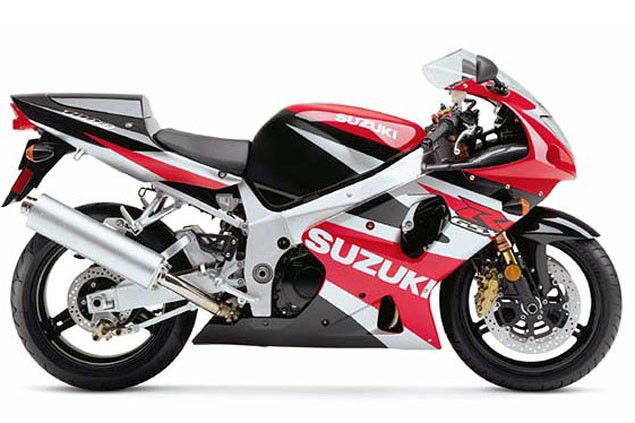
�
Sadly the years haven’t been kind on the GSX-R’s chassis. The brakes, which were once the best on any sporstbike, now feel old and weak and the suspension is soggy. Sportsbikes often don’t age well and this one feels tired, as well as big. To ride now the GSX-R feels huge, especially compared to modern tackle. And the riding position isn’t comfortable with low bars and a massive petrol tank spreading your legs wide. Some bikes, such as the ZX-9R can be classed as sports tourers now they have aged, the GSX-R doesn’t have this luxury.
But there is a larger fly in the GSX-R’s ointment, and that’s Suzuki’s build quality. Early GSX-Rs were built on a budget, and it shows. Even though this one is a tidy example you can see the TiN coating wearing off the fork legs, the clutch was grabby, the engine felt loose and rattled and the paint finish was very poor in areas. The problem is that the early noughties were a golden era for 1,000cc sportsbikes, and £4,000 gets you a wide selection. Given the cash Honda’s 954 FireBlade, reckoned by many to be the best Blade ever, offers considerably better build quality while still delivering the thrills when it comes to performance. But it is a Honda, and for summer kicks the wild image of GSX-R ownership could well be enough to sway potential owners towards the Suzuki.
Niall Says
If mad acceleration and ridiculous top speed is what you are after for four grand then the GSX-R is the only choice. That said, while the motor and transmission still felt sweet the dated looks (the colours didn’t help) would steer me away from this one. Back in 2002 this was the bike to beat on the road and track but six years of development means she is an O.A.P. now, particularly in the braking and handling department. A blue and white paint job, Brembo brakes and some K Tech suspension would fix things but then the cost totally defeats the object of this exercise.
Click next to continue
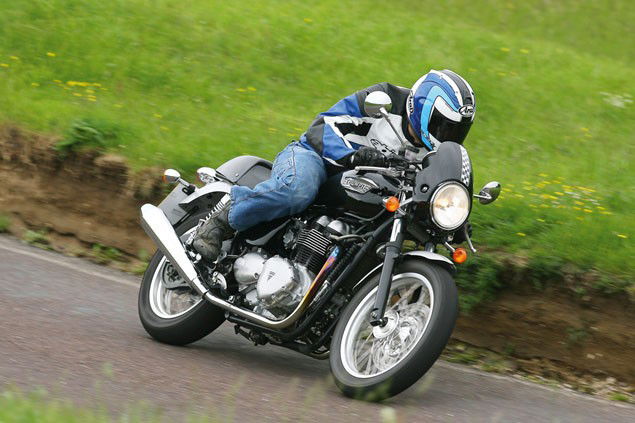
�
Triumph Thruxton
Click to read: Triumph Thruxton owners reviews
For anyone who lives at the end of a long, winding road. For anyone who wants the classic bike look, feel and sound without having to be a life-long member of the RAC.
Triumph’s Thruxton is nostalgia in a bottle...
Retro is something that, as you would expect, Triumph does extremely well. Its range of Bonneville based bikes are the perfect tools for summer rides. Then, in 2004, Triumph brought out the Thruxton, harking back to the days of café racers, chequered flag neckerchiefs and battered leather jackets.
Unfortunately at this point matters got a bit confused. With its racer image, low slung clip-on bars and new at the time 865cc parallel twin engine some riders assumed the Thruxton would be quite rapid. It wasn’t. Then a few other problems occured.
Generally potential owners of the Thruxton are somewhat on the older side, well older than when they were riding this style of bikes in the 1960s. As a result their wrists started to protest quite vigorously about the clip-ons and even the screw on petrol filler cap caused some difficulties. As a result finding a low mileage second hand Thruxton is fairly easy, which is a great result because it’s a lovely bike as long as you are aware of its limitations.
Click next to continue
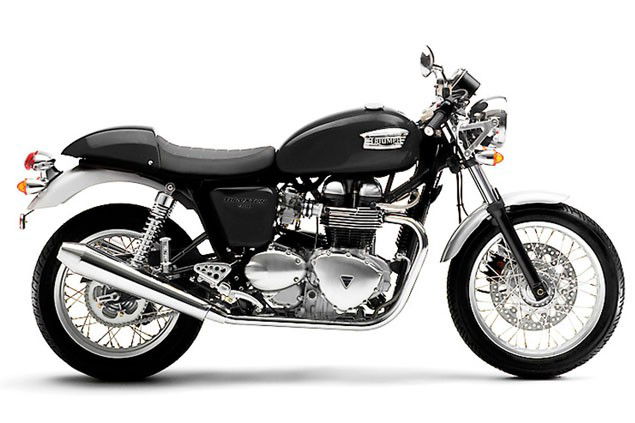
�
When you first ride the bike you are left thinking the engine is a bit flat. The Thruxton isn’t a quick bike, the engine doesn’t really have any power characteristics such as a top end rush and it’s fairly lethargic. But when you stop trying to rush around and treat the bike as a good looking machine for easy riding at a steady 60mph the Thruxton starts making sense.
The riding position is pretty uncomfortable after a few miles, and if you tuck your knees in they get super-heated by the engine, but this is easily forgotten. When you are riding the Thruxton it’s so easy to get lost in the moment, imagine that you are riding around in the 1960s, and be transported back to another time. It’s a pleasant, unintimidating and thoroughly enjoyable experience, and unlike bikes of that day the day the Triumph handles as well.
Obviously with its skinny tyres the Thruxton isn’t going to worry any modern sportsbikes, but it also isn’t going to wobble its way into the closest ditch. Most corners are easily attacked at a speed that is plenty fast enough and if you get really excited the tyres provide far more grip that you would expect. But that’s not really the Thruxton way of doing things. This is a bike for someone who knows who they are and what they’re into. You won’t be the fastest, but with a pair of open pipes and an open-faced helmet you’ll look by far the coolest when you turn up at your girlfriend’s house. Image is everything.
Niall Says
I rode a Thruxton to Fort William a few years ago and found it totally boring but my opinion has changed. Back then I had a preconceived idea that the Thruxton would have rough, 60’s edge to it and was disappointed when I found the motor to be, well, like a Honda. I now appreciate the Thruxton is a very civilised machine but quirky at the same time. I find the ‘feet back’ Bob McIntyre riding position to be quite relaxing and although you won’t win anything at Santa Pod the Thruxton will cruise at a sensible pace and pass most other road users if necessary.
Click next to continue
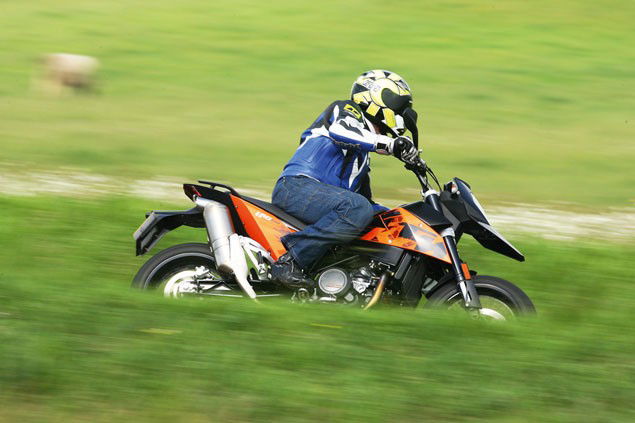
�
KTM 690SM
Click to read: KTM 690SM owners reviews
Supermotos have been around forever and will never work for anyone who has to ride more than 50 miles at a time. But for anyone who wants to rip up the city or country backroads this summer, there’s never been a better stress-reliever!
If someone asked me what the ultimate summer toy was I’d probably say a supermoto. If all you want a bike for is dicking around on a sunny day then you can’t beat these daft machines for providing simple, brain-out silliness and laughs. Try riding one further than a tank of petrol and these giggles are quickly replaced by tears, but for a Sunday morning cobweb clear out a few hours of stoppies, wheelies and general lunacy simply can’t be beaten. And if you want a supermoto then there is still only really one manufacturer to turn to - KTM.
The men in orange understand the ethos of supermoto perfectly, afterall they were arguably the first to make a road-going supermoto. But what we have here, on the face of it, is probably the biggest bargain of these four summer bikes. The 690SM is only a year old, but here we have a second hand one for £4,000, a saving of £1,895 on brand new.
Why is it so cheap? Well the problem with supermotos is that they’re one of those bikes that seem like a great idea to own, but in reality are very limited. They are a toy, not a practical day-to-day bike unless your commute is less than 30 miles. So despite the fact that KTM has made every effort to make the 690SM as practical as possible it’s still only really any good for short hops. The single cylinder engine is punchy, especially in the mid-range, but drop below about 2,000rpm and it stutters like crazy. This is normal behaviour for a single but still annoying when you aren’t in the mood to party.
Click next to continue

�
But get on a twisty back road and the SM comes alive. Although the long travel suspension makes the bike wobble a bit it soaks up the bumps and once you get used to the slightly vague feeling you can really go bananas. But it has to be the right road and you have to be prepared to treat the gearbox like a Morse code transmitter! In a lot of ways the supermoto is the two-stroke race rep of the 2000s, when its on the boil it’s brilliant fun, when it’s not it’s a right pain in the arse. And this is what makes it so unerringly brilliant at summer hacking.
As a second bike to go beserk on when your mate calls up and asks if you fancy going out for a ride, there’s nothing that can touch one of these being ridden properly. You simply keep the throttle pinned wide full open, shout at people and horses to stay out of the way and ride like a man (or woman) possessed. On the motorway this bike is purgatory, absolutely useless. But as a device for badness on innocent, unsuspecting roads, it is a weapon of matchless fun. You’ve just got to be in the right mood.
Niall Says
If I had to hand over my four grand without riding any of the four I would plump for the KTM. It just oozes quality and individuality plus it looked brand new. But then I rode it and realised it was far from a good summer all rounder. It is great in town for flicking through traffic and its lofty riding position is ace for country ‘B’ roads but at speeds over 70mph the fun stops. This is when the high riding position becomes a pain and as big singles were never designed for cruising you had better like lots of gear changing. The soft suspension is not ideal for the road but should you venture onto a green lane or forest track the other three wouldn’t see you for pine cones.
Click next to continue
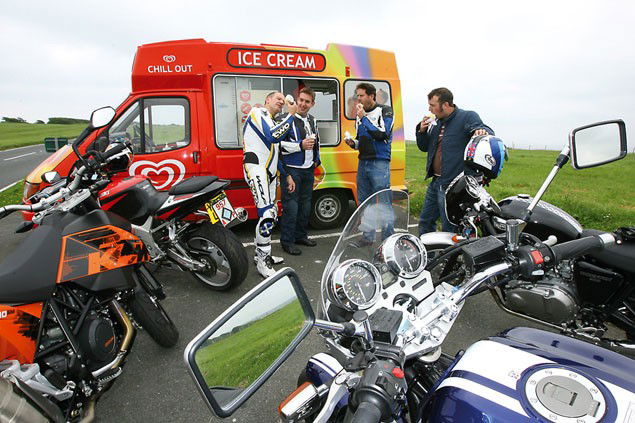
�
Conclusion
Once we’d all wiped the remains of 99 Flake off our assorted stubble it was time to make a decision on which bike was the one we’d take for a summer bike if we could have only one. And it was surprisingly easy.
The first bike we all wrote off the list instantly was the GSX-R1000. It’s a shame because the Suzuki is usually right up there when it comes to group tests, but the GSX-R is still just too rampant on one hand but too poorly-built on the other. Time has not been kind to the original Gixxer. Had it mellowed into a sporty sports tourer then it could have done more to justify its £4,000 price tag, but although the engine was still ballistic, the rest of the bike is now too dated.
The next to fall foul was KTM’s 690SM. Again, it’s a time and a place thing. If you live in town, don’t venture on journeys of any distance and are happy to spend your time working the gearbox then the SM will appeal. Unfortunatly for everyone else, it didn’t. It’s a great looking bike and a total bargain at the price, but just too limited, even for limited summer riding.
So it’s down to the two retro bikes, Triumph’s Thruxton and Yamaha’s XJR1300. Despite easily winnning the looks award the Thruxton’s uncomfy riding position and lack of any real pillion accomodation does make it a solo bike and limits its appeal. For some this is a plus point, but when you can have a really good looking retro bike, with a monster engine and better handling for the same cost, well that is enough to nudge the XJR1300 ahead.
For £4,000 the Yamaha will provide a glorious summer’s riding and well beyond. You can tour on it, have a laugh on twisty roads and even take a pillion in total comfort. The engine is hassle free, relaxing to use and yet still more than fast enough while the riding position is pure bliss. For lazy summer riding, this is surely the perfect bike.
Model Specifications
2007 KTM 690SM
Price: £4,000
Engine: 653cc, liquid-cooled, 4-valve single
Power: 63bhp @ 7,500rpm. Torque: 48 lb.ft @ 6,500rpm
Front suspension: 48mm non-adjustable
Rear suspension: WP monoshock, fully adjustable
Front brake: 320mm disc, four-piston radial caliper
Rear brake: 240mm disc, one-piston caliper
Dry weight: 152kg (claimed)
Seat height: 875mm fuel
Capacity: 13.5l
Top speed: 115mph (est)
Colours: orange, black
2005 Yamaha XJR1300
Price: £3,995
Engine: 1,251cc, air-cooled, 16-valve inline four
Power: 107bhp @ 7,700rpm
Torque: 77 lb.ft @ 6,600rpm
Front suspension: 43mm fully adjustable
Rear suspension: Öhlins twin shocks, fully adjustable
Front brake: 298mm discs, four-piston calipers
Rear brake: 267mm disc, two-piston caliper
Dry weight: 224kg (claimed)
Seat height: 775mm fuel
Capacity: 21l
Top speed: 137mph
Colours: black, blue, silver, yellow
2006 Triumph Thruxton
Price: £4,000
Engine: 865cc, air-cooled, 8-valve parallel twin
Power: 58bhp @ 6,900rpm
Torque: 48 lb.ft @ 2,800rpm
Font suspension: 41mm adjustable preload
Rear suspension: twin shocks, adjustable preload
Front brake: 320mm disc, two-piston caliper
Rear brake: 255mm disc, one-piston caliper
Dry weight: 205kg (claimed)
Seat height: 790mm fuel
Capacity: 16l
Top speed: 105mph (est)
Colours: black, red
2002 Suzuki GSX-R1000K2
Price: £4,000
Engine: 988cc, liquid-cooled, 16-valve inline four
Power: 153bhp @ 10,500rpm
Torque: 82 lb.ft @ 8,100rpm
Front suspension: 46mm fully adjustable
Rear suspension: fully adjustable monoshock
Front brake: 320mm discs, six-piston calipers
Rear brake: 220mm disc, one-piston caliper
Dry weight: 198kg (claimed)
Seat height: 830mm fuel
Capacity: 18l
Top speed: 181mph
Colours: White/blue, red/silver

